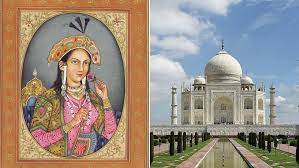The Cheek of Time (1652)
When flowers, chocolates, and Hallmark cards do not convey the depth of devotion, inspiration can be drawn from legendary lovers. German musician, Richard Wagner, composed the symphony “Siegfried Idyll” for his wife, Cosima. Russian Tsar Alexander III presented his Tsarina with the original Fabergé egg. Welsh actor Richard Burton gifted Elizabeth Taylor the fifty-carat La Peregrina pearl that had once graced the finger of Mary I of England. However, for romantic flourish, one can turn to the gesture of a Mogul emperor who erected the Taj Mahal in memory of his wife, Taj Mumtaz Mahal.
The world’s most famous monument to undying love had its genesis when the fifteen-year-old Shahab-ud-din-Muhammad Khurram strolled along the Meena Bazaar where he chanced upon a beautiful girl selling glass beads. The prince inquired as to the price of her wares, and in the age-old language of flirtation, she replied they were diamonds, ones he could not afford. The prince paid her the fantastic sum of ten thousand rupees and left carrying a glass bead—as well as the heart of Arjumand Banu Begum. 
Five years later, when the court astrologers finally agreed on an auspicious date, the couple was permitted to wed, and the prince’s father arranged for the wedding of the millennium. The uxorious husband built his wife sumptuous palaces, showered her in jewels, and ignored his polygamous rights with his two other wives. Upon his coronation, the prince became Shah Jahan, Persian for “king of the world.” His consort became Taj Mumtaz Majal, from ‘taj’ crown, and ‘mahal’ palace, thereby bestowing her with the honorific: crown of the palace. Their kingdom stretched from Russia to China and included modern India, Afghanistan, and Pakistan. The Shah’s golden Peacock Throne had as its centerpiece the Koh-I-Noor diamond that currently is one of Queen Elizabeth II’s most precious crown jewels.
The Shah and the Shahbanu could not bear to be apart, and Mumtaz Mahal gave up the luxuries of her palace to follow her husband on his campaigns of conquest. During one of these excursions, she became gravely ill following the birth of their fourteenth child. On her deathbed, Mumtaz Mahal requested a final gift: a monument to commemorate their love.
The bereaved husband determined to build the world’s most magnificent mausoleum, and from his far-flung empire, transported on the backs of elephants, came treasure troves of marble, gold, and jewels. A labor force of 20,000 men toiled on the tomb for two decades. The pool of water in front of the milky white structure reflects its beauty. Lore holds that the Shah ordered the blinding of his chief architect so he would never be able to reproduce the design. Aware that he had created the most spectacular structure in the world, he christened it after his lost love. The cost of construction in contemporary currency: $827 million.
After the Taj Mahal’s completion, Shah Jahal’s sons developed a Cain and Abel relationship and a fierce fight ensued to win the Peacock Throne. Aurangzeb, the most skillful in fratricide, emerged the victor. He imprisoned his father in the Red Fort that was the deposed ruler’s palace/prison for the remainder of his days. For the next eight years, Jahal gazed out the window at Mumtaz Mahal’s tomb.
According to Indian lore, during the rainy season only one droplet of rain falls on Mumtaz Mahal’s mausoleum, which led the Indian poet Rabindranath Tagore to describe the tomb as “one teardrop upon the cheek of time.”


